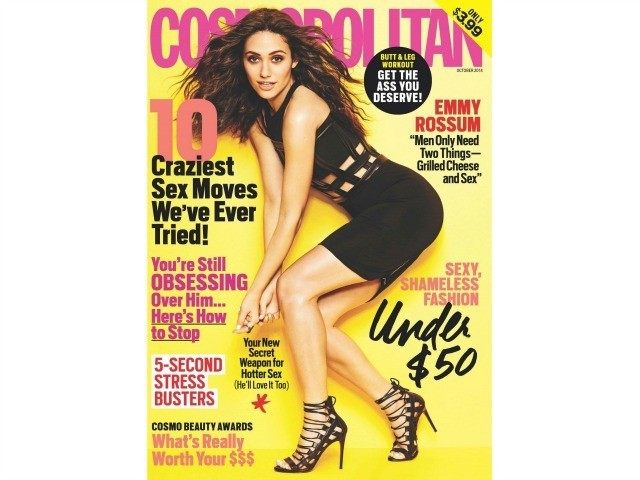A member of one of the world’s most powerful families just walked into a room filled with journalists and cameras, stepped up to a microphone, and proclaimd: enough is enough.
Bravo, Victoria Hearst. The granddaughter of newspaper magnate William Randolph Hearst is fed up with the sexually explicit rag Cosmopolitan, published by her family’s corporation. A woman of principle, she’s putting her money where her mouth is, and launching the campaign “Cosmo Harms Minors.”
I don’t need to describe the vulgar covers of Cosmo, do I? You’ve all seen them while standing in line at Walmart and Target. Trust me, your kids see them too.
Ms. Hearst’s campaign acknowledges First Amendment rights, but demands that Cosmo, like Playboy and Penthouse, be displayed behind blinders or in an opaque wrapper and sold only to adults. She considers those at the Hearst Corporation who are responsible for Cosmo guilty of targeting tweens and teens with pornographic material and glamorizing dangerous sexual choices.
Ms. Hearst is 100 percent correct: Cosmo is popular among teen girls, and the lifestyle it celebrates can be dangerous, even deadly, for them. The health hazards of early sexual activity, multiple casual partners, and anal intercourse – choices promoted in nearly every issue of Cosmo – have been described here by Michelle Cretella MD, president of the American College of Pediatricians.
What’s less well known, but just as serious, are the dangers of sex-centric magazines like Cosmo to girls’ emotional lives.
As documented in a report by the American Psychological Association, sexualization has significant negative mental health consequences for girls. According to the report, sexualization occurs “when a person is held to a standard that equates physical attractiveness (narrowly defined) with being sexy”, and when “a person is… made into a thing for others’ sexual use, rather than seen as a person with the capacity for independent action and decision making.”
There is ample reason for alarm, says the APA, because sexualization of girls permeates the culture and media, and many young woman are vulnerable and easily influenced.
Frequent exposure to the images and content that fill Cosmo can negatively affect a girl’s developing sense of self and how she conceptualizes femininity and sexuality. She is more likely to objectify her own body and self. She may accept more constrained and stereotypical notions about gender and sexual roles.
Hardly a surprise that the sexualization and objectification of girls is linked to three of the most common mental health problems of girls and women: eating disorders, low self-esteem, and depressed mood.
When girls are sexualized, the APA underscores, it may also have a negative impact on boys, men, and adult women. “Exposure to narrow ideals of female sexual attractiveness may make it difficult for some men to find an ‘acceptable’ partner or to fully enjoy intimacy…” The idealization of youth as the only attractive stage of life is damaging to women as they age.
You don’t need a PhD to realize those truths.
I began to review recent issues of Cosmo for examples of sexualization, but soon stopped. Aside from a few ads for pet food and sanitary napkins, it’s ubiquitous. Nearly every page instructs girls: Your goal is to please men; to succeed, you must look sexy and available. He must like your skin, hair, smile, and scent. If there was ever a textbook example of the sexualization of girls, it’s Cosmopolitan.
We in the medical profession consider it our duty to warn parents about fatty foods, sugar, and high glycemic diets. The mayor of New York introduced legislation to limit the size of sodas. Michelle Obama fought to purge school vending machines of M&M’s and Fritos. Everyone is focused on what’s entering kids’ mouths.
Physical health is critical, yes, but what about young people’s inner lives? What about the ideas and images they consume? Those can be much more toxic than a Big Gulp.
Personally, I’d rather my daughter occasionally binge on ice cream and French fries than ingest the depraved and demeaning content of Cosmo.
The magazine is not just a nasty staple of the checkout line to which many of us have become desensitized. Cosmo is poison to the emotional lives of our precious girls.
It’s the job of responsible adults to protect their young. Shame on those at the Hearst Corporation, and those retailers, who facilitate minors’ access to Cosmo. Thank you Victoria, for spearheading this critical campaign.
Let’s protect our daughters. Enough is enough.
Miriam Grossman, MD is a practicing physician, author, and speaker who is known internationally for her courage in calling foul on the Sexuality Education industry. Follow her at http://www.miriamgrossmanmd.com/blog/ and at https://www.facebook.com/MiriamGrossmanMD

COMMENTS
Please let us know if you're having issues with commenting.